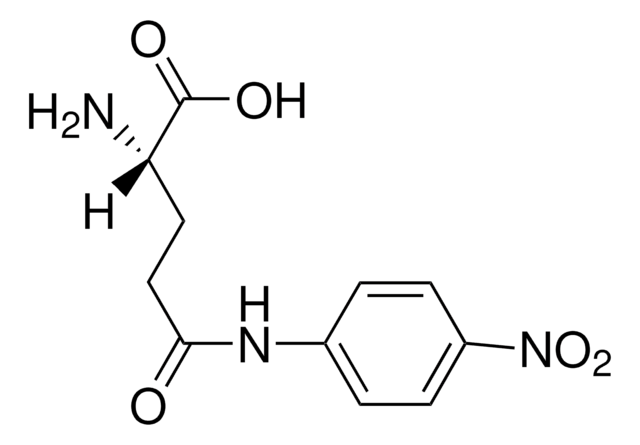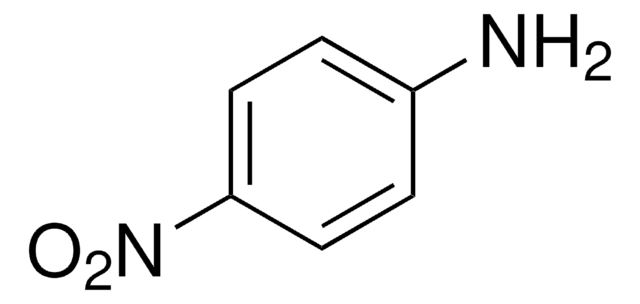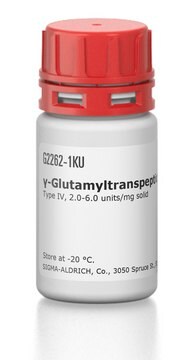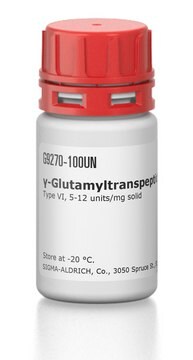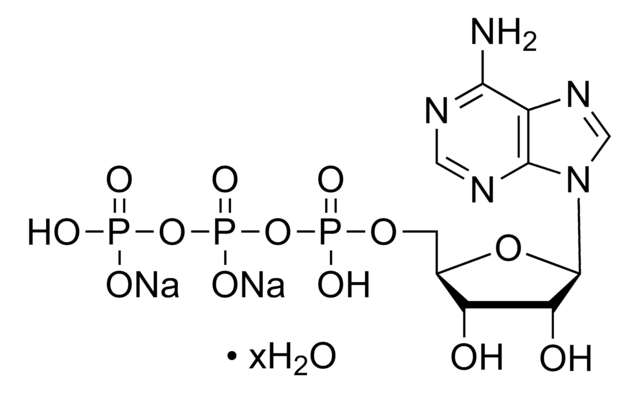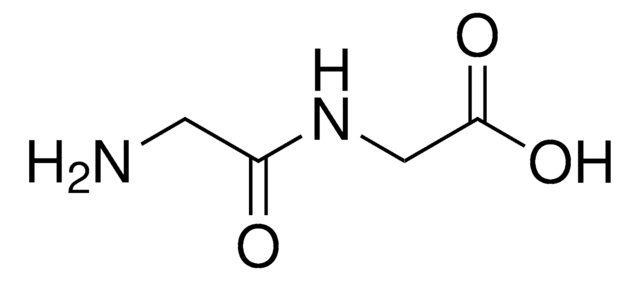Wszystkie zdjęcia(4)
Kluczowe dokumenty
G6133
L-Glutamic acid γ-(p-nitroanilide) hydrochloride
γ-glutamyl transpeptidase substrate
Synonim(y):
L-γ-Glutamyl-p-nitroanilide
Zaloguj sięWyświetlanie cen organizacyjnych i kontraktowych
About This Item
Wzór empiryczny (zapis Hilla):
C11H13N3O5 · HCl
Numer CAS:
Masa cząsteczkowa:
303.70
Numer WE:
Numer MDL:
Kod UNSPSC:
12352204
Identyfikator substancji w PubChem:
NACRES:
NA.83
Polecane produkty
Poziom jakości
Próba
≥98% (HPLC)
Formularz
powder
rozpuszczalność
water: 5 mg/mL, clear, yellow
temp. przechowywania
2-8°C
ciąg SMILES
Cl.NC(CCC(=O)Nc1ccc(cc1)N(=O)=O)C(O)=O
InChI
1S/C11H13N3O5.ClH/c12-9(11(16)17)5-6-10(15)13-7-1-3-8(4-2-7)14(18)19;/h1-4,9H,5-6,12H2,(H,13,15)(H,16,17);1H
Klucz InChI
OJEVFSFTVARWQX-UHFFFAOYSA-N
Zastosowanie
L-Glutamic acid γ-(p-nitroanilide) hydrochloride has been used as a solute carrier family 1 member 5 (SLC1A5) inhibitor:
- or an inhibitor of the cell membrane glutamine transporter to study the effects of blocking glutamine uptake on esophageal adenocarcinoma (EACC) and thioredoxin-interacting protein (TXNIP)
- in glutamine ELISA assay to treat confluent differentiated uninfected human colonoid monolayer (HCM) in apical and basolateral compartments to study its effects
- to study its effect on SLC1A5_var-mediated mitochondrial glutamine transport inhibition
- to study its effects on cellular glutathione levels, cellular reactive oxygen species (ROS) levels, and mitochondrial ROS levels
Działania biochem./fizjol.
L-Glutamyl-p-nitroanilide (GPNA) is commonly used to block the glutamine (Gln) transporter alanine-serine-cysteine transporter 2 (ASCT2). It can also inhibit sodium-dependent and independent amino acid transporters. GPNA, γ-glutamyltransferase (GGT) substrate plays a key role in the hydrolysis of its γ-glutamyl bond and the subsequent release of the chromogen, p-nitroaniline (PNA).
Substraty
Substrate for γ-glutamyl transpeptidase
Ta strona może zawierać tekst przetłumaczony maszynowo.
Kod klasy składowania
11 - Combustible Solids
Klasa zagrożenia wodnego (WGK)
WGK 3
Temperatura zapłonu (°F)
Not applicable
Temperatura zapłonu (°C)
Not applicable
Środki ochrony indywidualnej
Eyeshields, Gloves, type N95 (US)
Wybierz jedną z najnowszych wersji:
Masz już ten produkt?
Dokumenty związane z niedawno zakupionymi produktami zostały zamieszczone w Bibliotece dokumentów.
Klienci oglądali również te produkty
Paul L Feingold et al.
Molecular cancer therapeutics, 17(9), 2013-2023 (2018-06-24)
In 2017, an estimated 17,000 individuals were diagnosed with esophageal adenocarcinoma (EAC), and less than 20% will survive 5 years. Positron emission tomography avidity is indicative of high glucose utilization and is nearly universal in EAC. TXNIP blocks glucose uptake
Alessandro Corti et al.
Scientific reports, 9(1), 891-891 (2019-01-31)
L-γ-Glutamyl-p-nitroanilide (GPNA) is widely used to inhibit the glutamine (Gln) transporter ASCT2, but recent studies have demonstrated that it is also able to inhibit other sodium-dependent and independent amino acid transporters. Moreover, GPNA is a well known substrate of the
Alessandro Corti et al.
Scientific reports, 9(1), 891-891 (2019-01-31)
L-γ-Glutamyl-p-nitroanilide (GPNA) is widely used to inhibit the glutamine (Gln) transporter ASCT2, but recent studies have demonstrated that it is also able to inhibit other sodium-dependent and independent amino acid transporters. Moreover, GPNA is a well known substrate of the
Long-Liu Lin et al.
Applied microbiology and biotechnology, 73(1), 103-112 (2006-07-20)
A truncated gene from Bacillus lichenifromis ATCC 27811 encoding a recombinant gamma-glutamyltranspeptidase (BLrGGT) was cloned into pQE-30 to generate pQE-BLGGT, and the overexpressed enzyme was purified from the crude extract of IPTG-induced E. coli M15 (pQE-BLGGT) to homogeneity by nickel-chelate
M Moriguchi et al.
Archives of microbiology, 144(1), 15-19 (1986-02-01)
Three gamma-glutamyltranspeptidase (enzymes I, II and III) were partially purified from the cell free extracts of the cultured mycelia of Morchella esculenta Fr. The molecular masses of enzymes were 155,000 (I), 219,000 (II) and 102,000 (III). All of them catalyzed
Nasz zespół naukowców ma doświadczenie we wszystkich obszarach badań, w tym w naukach przyrodniczych, materiałoznawstwie, syntezie chemicznej, chromatografii, analityce i wielu innych dziedzinach.
Skontaktuj się z zespołem ds. pomocy technicznej